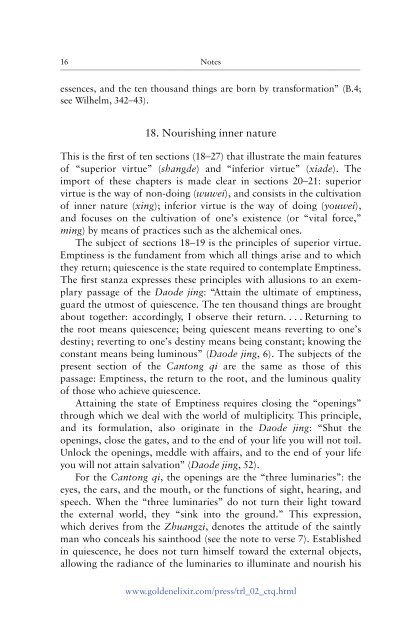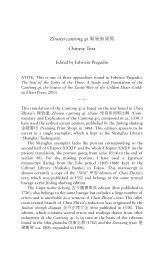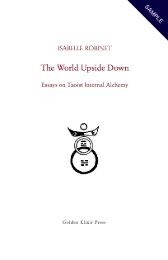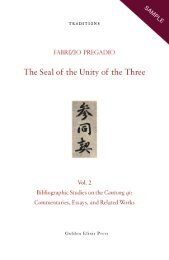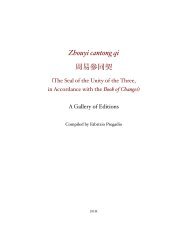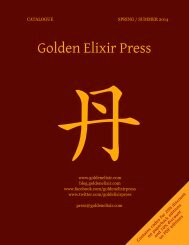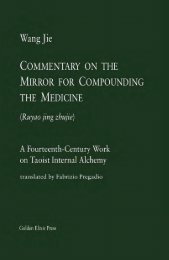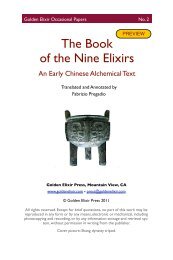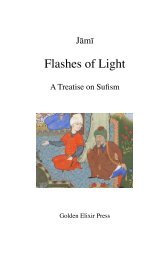The Seal of the Unity of the Three - The Golden Elixir
The Seal of the Unity of the Three - The Golden Elixir
The Seal of the Unity of the Three - The Golden Elixir
You also want an ePaper? Increase the reach of your titles
YUMPU automatically turns print PDFs into web optimized ePapers that Google loves.
16 Notes<br />
—————————————————————————————————————————<br />
essences, and <strong>the</strong> ten thousand things are born by transformation” (B.4;<br />
see Wilhelm, 342–43).<br />
18. Nourishing inner nature<br />
This is <strong>the</strong> first <strong>of</strong> ten sections (18–27) that illustrate <strong>the</strong> main features<br />
<strong>of</strong> “superior virtue” (shangde) and “inferior virtue” (xiade). <strong>The</strong><br />
import <strong>of</strong> <strong>the</strong>se chapters is made clear in sections 20–21: superior<br />
virtue is <strong>the</strong> way <strong>of</strong> non-doing (wuwei), and consists in <strong>the</strong> cultivation<br />
<strong>of</strong> inner nature (xing); inferior virtue is <strong>the</strong> way <strong>of</strong> doing (youwei),<br />
and focuses on <strong>the</strong> cultivation <strong>of</strong> one’s existence (or “vital force,”<br />
ming) by means <strong>of</strong> practices such as <strong>the</strong> alchemical ones.<br />
<strong>The</strong> subject <strong>of</strong> sections 18–19 is <strong>the</strong> principles <strong>of</strong> superior virtue.<br />
Emptiness is <strong>the</strong> fundament from which all things arise and to which<br />
<strong>the</strong>y return; quiescence is <strong>the</strong> state required to contemplate Emptiness.<br />
<strong>The</strong> first stanza expresses <strong>the</strong>se principles with allusions to an exemplary<br />
passage <strong>of</strong> <strong>the</strong> Daode jing: “Attain <strong>the</strong> ultimate <strong>of</strong> emptiness,<br />
guard <strong>the</strong> utmost <strong>of</strong> quiescence. <strong>The</strong> ten thousand things are brought<br />
about toge<strong>the</strong>r: accordingly, I observe <strong>the</strong>ir return. . . . Returning to<br />
<strong>the</strong> root means quiescence; being quiescent means reverting to one’s<br />
destiny; reverting to one’s destiny means being constant; knowing <strong>the</strong><br />
constant means being luminous” (Daode jing, 6). <strong>The</strong> subjects <strong>of</strong> <strong>the</strong><br />
present section <strong>of</strong> <strong>the</strong> Cantong qi are <strong>the</strong> same as those <strong>of</strong> this<br />
passage: Emptiness, <strong>the</strong> return to <strong>the</strong> root, and <strong>the</strong> luminous quality<br />
<strong>of</strong> those who achieve quiescence.<br />
Attaining <strong>the</strong> state <strong>of</strong> Emptiness requires closing <strong>the</strong> “openings”<br />
through which we deal with <strong>the</strong> world <strong>of</strong> multiplicity. This principle,<br />
and its formulation, also originate in <strong>the</strong> Daode jing: “Shut <strong>the</strong><br />
openings, close <strong>the</strong> gates, and to <strong>the</strong> end <strong>of</strong> your life you will not toil.<br />
Unlock <strong>the</strong> openings, meddle with affairs, and to <strong>the</strong> end <strong>of</strong> your life<br />
you will not attain salvation” (Daode jing, 52).<br />
For <strong>the</strong> Cantong qi, <strong>the</strong> openings are <strong>the</strong> “three luminaries”: <strong>the</strong><br />
eyes, <strong>the</strong> ears, and <strong>the</strong> mouth, or <strong>the</strong> functions <strong>of</strong> sight, hearing, and<br />
speech. When <strong>the</strong> “three luminaries” do not turn <strong>the</strong>ir light toward<br />
<strong>the</strong> external world, <strong>the</strong>y “sink into <strong>the</strong> ground.” This expression,<br />
which derives from <strong>the</strong> Zhuangzi, denotes <strong>the</strong> attitude <strong>of</strong> <strong>the</strong> saintly<br />
man who conceals his sainthood (see <strong>the</strong> note to verse 7). Established<br />
in quiescence, he does not turn himself toward <strong>the</strong> external objects,<br />
allowing <strong>the</strong> radiance <strong>of</strong> <strong>the</strong> luminaries to illuminate and nourish his<br />
www.goldenelixir.com/press/trl_02_ctq.html


